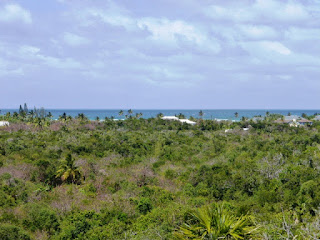One thing the guide book was spot on about was this wonderful nature park. We weren't expecting much since they had made every place sound great but we were pleasantly surprised. Leon Levy was a successful investment banker on Wall Street and he and his wife loved to vacation on Eleuthera. Upon his death, she set up a foundation in conjunction with the Bahamas National Trust endowing a park that will preserve native species and tell the story of the Bahamas through plants. It is obviously very well endowed. We have never seen any park in the Bahamas as well maintained and laid out. The others we have visited struggle to keep themselves intact and undeveloped. Well done, Mrs. Levy for insuring enough funds were available to do it right!
 |
The entrance to the park was this dramatic water feature. The two caretakers
we met were very professional and had a wealth of knowledge about
their park and the plants in it. One gave us a short briefing on what we
would see and the founding of the park. |
 |
The major paths were wide with the smaller ones winding along the
sides of the hills. In a relatively small area, they managed several miles
of trails. All of them were lined on both sides with distinctive rocks
and the paths were covered in tiny wood chips. |
 |
| This grand pavilion was the perfect spot for our PB&J sandwiches. |
 |
| This tower rose about 200 feet from the trail well above the treetops. |
 |
| In one direction from the tower, you can see the bight. |
 |
| On the other side, you can see a salt pond. |
 |
This handsome critter obligingly posed for me. If you notice, the signs all
identify the plants by their local or common name and their Latin name.
In our garden club, Marie always stresses learning the Latin names and it sure came
in handy here. The common names are nothing that I was used to but I could
recognize the Latin name. |
 |
We couldn't believe fruit this size grew on trees instead of vines. Sadly, this
area was being worked on and the tree's sign was missing. |
 |
One entire section of the park was dedicated to the history of the Bahamas through
its edible plants. Originally only 3 varieties existed. This is a recreation of a Lucayan dwelling.
They were the original inhabitants of the region. Sadly, they were wiped out by disease
and slaving within a generation. |
 |
No need for green houses in the warm climate. Instead, new plants
are brought along in this shade shed. |
 |
Another section was dedicated to the water plants of the Bahamas from pond
flowers to mangroves. Other sections included orchids and bromeliads, plants
used in making medicines and plants attractive to birds. |











No comments:
Post a Comment